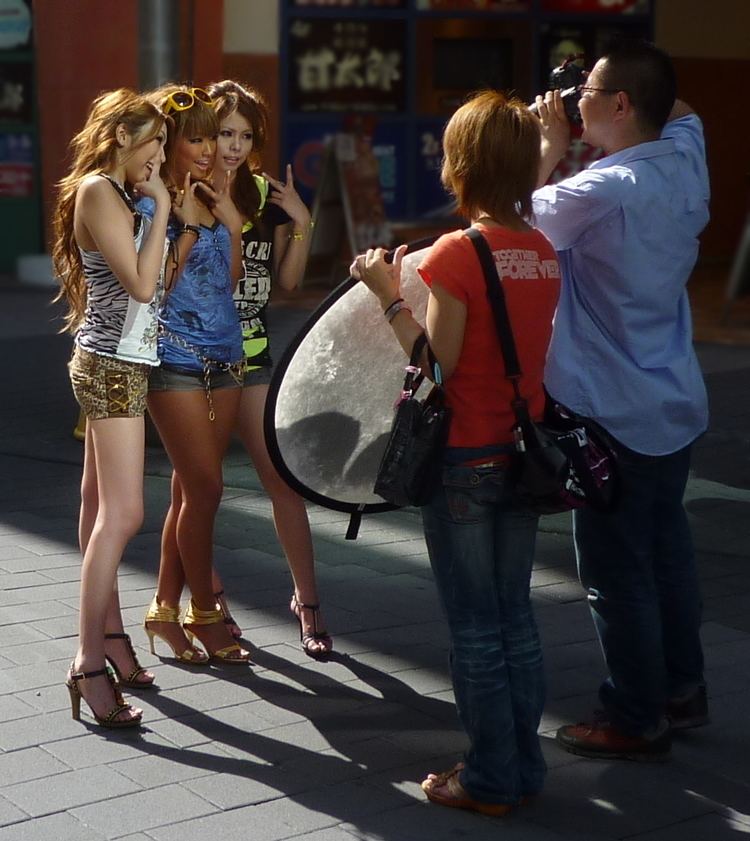Gyaru (ギャル) is a Japanese transliteration of the English word 'girl'. The name originated from a 1970s brand of jeans called "gurls", with the advertising slogan: "I can't live without men", and was applied to fashion- and peer-conscious girls in their teens and early twenties. Its usage peaked in the 2000s and has gradually declined. The term gradually drifted to apply to an older group, whose seeming lack of interest in work or marriage gained the word a "childish" image. It is now used almost interchangeably with kogal.
Gyaru subculture is still a large influence in Japan's fashion economy with gyaru brands branching out and becoming more accessible in rural areas. In Tokyo, more often than not, a shopping center at each main train station is dedicated to offering the newest and trendiest items from popular Gal brands. Some brands are also reaching overseas by having their items easily accessible in webshops offering world-wide shipping services. A Gal Circle is a meet up of gals to hang out together.
Gyaru fashion and style varies greatly dependent on the subcategory. Although in general the term describes the fashion and glamour reminiscent of Brigitte Bardot with tanned skin and blonde hair. The term is also often applied to those imitating the bihaku glamour style created by Ayumi Hamasaki and the street style started by Namie Amuro. Styles derived from gyaru are often referred to by their subcategory name.
Gyaru fashion is a type of Japanese street fashion that originated in the 1970s. Its popularity peaked in the 1990s and early 2000s. Gyaru fashion is typically characterized by having heavily bleached or dyed hair (mostly shades from dark brown to blonde), highly decorated nails, and dramatic makeup. The makeup typically consists of dark eyeliner and fake eyelashes used in ways intended to make the eyes appear larger, as well as contouring of the face for a slimming effect. Clothing pieces for gyaru fashion differ depending on which gyaru style the individual chooses. Popular gyaru models, icons and idols include Tsubasa Masuwaka, Kumiko Funayama, (Kumicky), Rie Matsuoka (Okarie), Hikari Shiina (Pikarin), Satomi Yakuwa (Satomin), Sayoko Ozaki, and Rina Sakurai.
There are various subcategories of "gals" depending on the choice of fashion, and also gender.
Gyaru-kei (ギャル系): Basically the default gyaru style. It is an umbrella term for the many subcategories or themes of gal styles.Bibinba (ビビンバ): This look usually includes a lot of gold, and jewelry. Similar to b-gal. It was said to be a joke in Egg magazine about this style, and was not a serious style.Banba (バンバ): Banba is a lighter form of manba. Banbas wear less white makeup than manbas; they also use more glitter, and may or may not have neon colored hair. Banbas wear more extreme-looking types of false eyelashes, and colored contact lenses. Banbas wear darker colors than manbas, and sometimes dress in club wear.Hime gyaru : Also known as Hime-kei. It is one of the more over the top and also one of the most expensive style of dress of all of the categories. The hime style is largely based on the Rococo era. Gyaru of this style wear dresses or skirts in pink or other pastels with lots of lace and bows. Rose patterns, pearls and crown motifs are also very common. Headpieces range from large bow clips with pearls to rose accents, while the hair is either bleached, poofed up in a bouffant at the top and curled or a wig/extensions are worn. The make-up style has even more exaggerated eyes than the typical gyaru. Hime gyaru does not only include clothes, but many girls see it as a way of life and make or buy custom-made decor for their homes. The style blossomed in the early 2000s but has since declined or turned more casual (this version is referred to as hime kajii), even if the old one is still present. Not to be confused with Lolita fashion.Ganguro: A gyaru with an artificial deep tan and bleached hair. This style was popular in the late 1990s and early 2000s.Western gyaru, Amerigyaru, etc. Girls and also guys who have found gyaru fashion outside Japan (Western gyaru includes countries in the west.). The term Amerigyaru was short lived, and was used for people who identified with gyaru lifestyle and/or fashion in America. Western/Gaijin gyaru have their own communities, and forums with lists of tutorials to help beginner gyaru with make up and hair basics and to also meet up with each other during travel if they so choose.Gyaruo (ギャル男): A male gyaru. Typically, gyaruo have similar elements to their appearance with gyaru in terms of having high volume styled hair, trendy fashion styles, and sometimes tanned skin.Kogyaru: Generally a high school student (高校生 kōkōsei).JK gyaru: term for kogyaru in school uniformsAne gyaru: Gyaru style that has the yanki and biker gang culture with gyaru make up and style. The girls drive or ride bikes, and tend to have tattoos and piercings. They not only look rebellious, but the magazine caters to girls who live on the edge. Ane gyaru is more of a tougher version of Onee gyaru, and are for a bit more mature gals. Magazine of choice for fans and followers is Soul Sister, a relatively new magazine.Yamanba: Like manba, but the nose stripe goes past the eyebrows.Gyaru mama (ギャルママ): gyaru girls who continued the style after having children. BBC News states: "Gal-mama are young mothers who refuse to shed their gal-ness."Gyaru clothing and accessory brands
Notable Japanese Gyaru brands:
Liz LisaCecil McBee13 JapanEmodaJSGLa PafaitJesus DiamanteBaby ShoopAlba RosaBlack QueenEggMensEGGHappie NutsKoakuma AgehaPopSisterPopteenRanzukiCawaii!I Love MamaSoul SisterJellyBlendaMusic is not a hobby within gyaru culture, although Jpop and Eurobeat remixes of popular Japanese singers are casually listened to, mostly during a date or when driving a car. Some gyaru listen to rock, rap and all sorts of music, and is not limited to Jpop and Eurobeat music.

